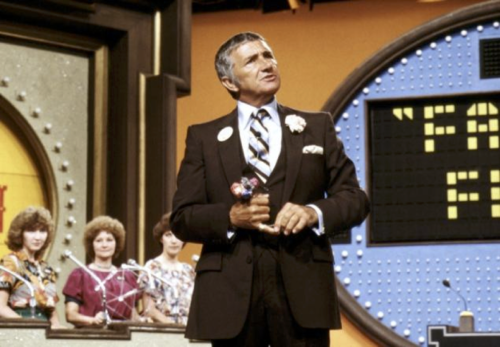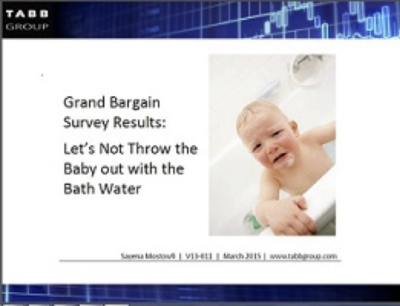Joseph Saluzzi (jsaluzzi-at-ThemisTrading.com) and Sal L. Arnuk (sarnuk-at-ThemisTrading.com) are co-heads of the equity trading desk at Themis Trading LLC (www.themistrading.com), an independent, no conflict agency brokerage firm specializing in trading listed and OTC equities for institutions. Prior to founding Themis, Sal and Joe worked for more than 10 years at Instinet Corporation, pioneers in the field of electronic trading, and at Morgan Stanley.
~~~
Surveys are a data collection tool often used to gather information about individuals, and their opinions on topics. Surveys are generally standardized to ensure that they have validity. Hopefully they are large enough to be statistically meaningful, and hopefully they are created and analyzed objectively – and not subjectively. Often, great care is used in constructing and wording questions, so that they are not leading, and that the responses they elicit are meaningful. Often great care is exercised to make sure the surveys are not biased. Questions need to be asked correctly!
For example, the following two questions deal with the same subject matter – and they might yield different results:
1) Do you agree or disagree that current equity market structure is for the most part fair?
2) Current equity market structure has portions that are unfair. Do you agree or disagree?
Surveys are nice. They allow us to gauge how we feel versus some other representative group. And approaching the one year anniversary of the release of Michael Lewis’s Flash Boys, a lot of market structure surveys have been floating around.
This morning we want to alert you to three of them: Tabb’s Grand Bargain Survey (Mostowfi), Convergex’s US Equity Market Structure Flashback Survey, and Liquidnet’s Institutional Voice 2015.
Tabb’s Grand Bargain Survey:
Sayena Mostowfi has been working on this survey for many months. Click on that link to the survey from January. Mostowfi doesn’t just ask the questions, She tells you what she and Tabb thinks before you take the survey!
In completing the survey, we ask that you consider the following TABB observations:
1. Best Execution vs. Regulation NMS – Any changes to Reg NMS’s Order Protection Rule (“trade through rule”) and/or access fee caps would not impact a broker’s obligation to seek the best price for their customer, although it may complicate it.
2. Fragmentation –US stock exchange ownership is not highly fragmented.
3. Price Discovery: Quotes and Trades – Post-trade transparency exists in real time for all US equity volume, on- and off-exchange. Similar to off-exchange venues, pre-trade transparency does not exist for hidden orders on exchanges.
4. Targeted Regulation vs. Market Forces –It is important to treat the cause and not the symptoms of market structure issues and allow market forces to take their course, aided by uniform transparency measures and updates to broker-dealer best execution obligations.
5. Perfect Solutions Not Required –It is worth repeating Chair White’s sentiment that, “while we do not require perfect solutions, our regulatory changes must be informed by clear-eyed, unbiased, and fact-based assessments of the likely impacts — positive and negative — on market quality for investors and issuers. Continued engagement by all market participants on these issues is critical.”
We thank you in advance for your participation in our first 2015 Equity Market Structure Reform Survey.
From Tabb’s website, the results are summarized by the statement “Let’s Not Throw the Baby out with the Bath Water.” According to Trader’s Magazine, Mostowfi surveyed 140 industry participants that included bulge brokers, buyside, exchanges, academics, and vendors and consultants that sell technology. 14% of the survey respondents were actually buyside – 20 people. Those are the opinions Themis would especially care about in the Tabb survey. I apologize in advance for not spending $3,000 to find out what those 20 buyside traders think. You are welcome to – here is the link.
Convergex’sUS Equity Market Structure Flashback Survey
Eric Noll summarizes the survey on the first page:
While our industry continues to grapple with a complex and challenging market structure, volatility has remained at historically low levels, the S&P 500 is up 12% since this time last year and we’ve seen the largest IPO ever go off without a hitch. And as the results of our new U.S. Equity Market Structure “Flashback” Survey show, fewer people now believe that “the house is on fire”.
Away from the hype and the headlines, we hope that the results of this survey help you understand how the industry currently views the market structure debate, and that together we can find the right solutions for you.
Generally, Eric points out that you all feel a little better today than versus one year ago. Perhaps it is because the SEC has done much more fining – including fining Convergex. Perhaps it is because an intense regulatory focus on dark pools in the last year has had the effect of cleaning up a thing or two. Or perhaps, according to Nanex, it is because Convergex interviewed fewer buyside traders this year versus last year:
Liquidnet’s Survey: Institutional Voice 2015
Liquidnet’s surveyed 115 of its own buyside customers, and found that:
– 75% of them are concerned about conflicts of interest in the industry
– 88% of them are concerned about predatory traders in dark pools.
– 76% of them believe that HFT strategies can hurt them, sometimes.
Each of these surveys has different degrees of usefulness, from our perspective. We tend to like the ones that talk to more buyside traders rather than fewer. Convergex spoke to 140 (240 a year ago). Liquidnet spoke to 115. Tabb spoke to 20.
If you feel better today than you did right after the release of Flash Boys, ask yourselves why. Is it because you made changes to how you trade? Is it because you have asked for, and received, more transparency around your order routing? Is it because the Regulators have been very busy this past year, and are likely to be “shining more light” in the next year? Is your increased confidence in market structure today proof positive that concerns have been overblow in the past, or that your concerns are starting to get addressed!
Enjoy the surveys, and as always, make your own judgements.




